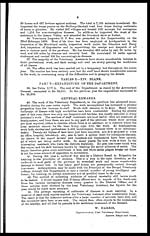Medicine - Veterinary > Civil Veterinary Departments > 1907-1911 - Report on the Civil Veterinary Department, Eastern Bengal and Assam > Report of the Civil Veterinary Department, Eastern Bengal and Assam, for the year 1907-1908
(41) Page 5
Download files
Individual page:
Thumbnail gallery: Grid view | List view

5
patients. Last year, there were 647 in-patients and 6,231 out-patients. There is a
decrease in the number of in-patients and an increase of 7,269 out-patients during
the year under report. It is evident that these institutions are becoming increasingly
popular, and that stock-owners are rapidly learning the value of veterinary aid.
29. Rangpur veterinary dispensary was opened on the 1st August 1907. The
buildings, consisting of a cattle-shed, pharmacy, office, and assistant's quarters, are
placed in a large compound near the bazar. The District Board constructed the
dispensary at a cost of Rs. 7,500. A contribution of Rs. 4,000 was given by Srimati
Bhobo Sundari Debya Chaudhurani in memory of her deceased husband, Babu Jogendra
Narain Boy Chaudhury, Zamindar of Pirgacha. A commemoration tablet has been
placed in the building. A good supply of instruments and drugs has been provided..
Previously the want of veterinary aid was greatly felt in this district. Since the opening
of the dispensary good work has been accomplished, and its advantages are rapidly
becoming known to animal owners in the district. Two hundred and forty-four animals
have been treated, and the average daily attendance since the opening day has
been 4.3.
30. The income and expenditure of veterinary hospitals and dispensaries are shown
in table VI. The minus balance of Rs. 733 shown at Chittagong is only a temporary
deficit, due to delay in the payment of the Municipal contribution. A deficit of
Rs. 763 in last year's abstract was due to the same cause. The amount received from
fees is Rs. 116-14-6, being an increase of Rs. 73-7-6 on the last year's fees. As most
of the veterinary work is done in the free clinique and the people in the districts are
generally poor, there can be no great increase in the amount of fees received.
PART III.—BREEDING OPERATIONS.
31. At the beginning of the year there was one bull, the property of the Govern-
ment, in this province. Being past work it has been disposed of and will be replaced
by a suitable Patna bull as soon as possible. There are 26 bulls, the property of
District or Local Boards: no bulls have been purchased, and no casualities have been
reported.
32. Table IX shows the work of the Provincial cattle farm for the year 1907-
1908. The total number of animals on the 1st March 1908 was 94, made up of 1 bull,
36 cows, 12 young bulls, 26 heifers, 8 bull calves and 9 heifer calves of different
breeds and 2 bullocks. The cows are of the following breeds—pure Patna, pure Khasi,
pure Bhutia, Patna-Khasi cross and Patna-Bhutia cross. The Patna crosses show an
all-round improvement in height, strength of bone, and general build. The average
yield of milk is also increased. A cow of the Patna-Khasi cross gave 4 seers of milk
when in full flow, which is a considerable increase on the 1½—2 seers usually given.
Five eighteen-months old bulls and one Khasi cow were sold during the year.
The demand for young Patna stock is increasing, and cannot be fully met. The
total amount of milk sold during the year was 270 maunds, valued at Rs. 1,333.
The quantity of milk sold is now greatly reduced, as most of it is required for the
young stock. Young bulls will not in future be sold under three years of age.
33. A herd of English pigs which has been maintained at the farm since December
1902, having failed to become popular amongst the Khasis, has been disposed of.
PART IV.—SUBORDINATE ESTABLISHMENT.
34. Table VII shows the strength of the subordinate staff. During the year
sixteen graduates from the Bengal Veterinary College joined the Department. One
Assistant has been posted to each of the following places: Dacca, Mymensingh,
Faridpur, Pabna, Rajshahi, Malda, Noakhali, Comilla and Rangpur in East Bengal,
and Habiganj, Goalpara, Dhubri, Gauhati, Shillong, Tezpur, and Mangaldai in Assam.
At the beginning of the year the strength of the Department was one Inspector and
eleven assistants. During the year one assistant resigned, one was promoted to
Inspector and sixteen joined the department, so that on the 31st March 1908 the total
strength was two Inspectors and twenty-five veterinary assistants. Five of these
were paid from Provincial funds and the remainder from District or Local Board
funds.
35. Veterinary Inspector S. Mukherjee, during the year under report, has done
very useful work in the Assam Valley. He was on tour 236 days and travelled 4,872
miles by rail, 1,238 miles by road and 1,957 miles by steamer and country boat.
Much of his time has been taken up in inoculating work, trained assistants not
being available. In the district of Lakhimpur he inoculated 1,880 bovines and 154
other animals, in Sibsagar district 3,472 bovines and 32 others, in Darrang 1,112
bovines, and in Kamrup 38 bovines, all against rinderpest. In Nowgong he inoculated
Set display mode to: Large image | Zoom image | Transcription
Images and transcriptions on this page, including medium image downloads, may be used under the Creative Commons Attribution 4.0 International Licence unless otherwise stated. ![]()
| Permanent URL | https://digital.nls.uk/75721831 |
|---|




